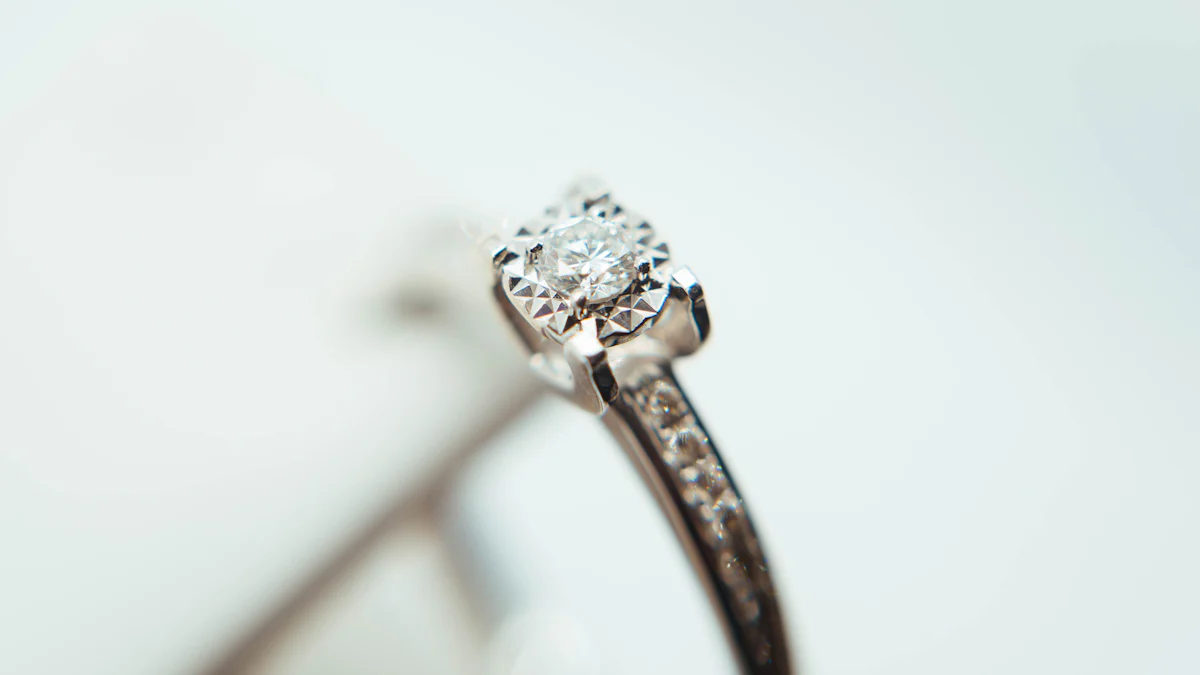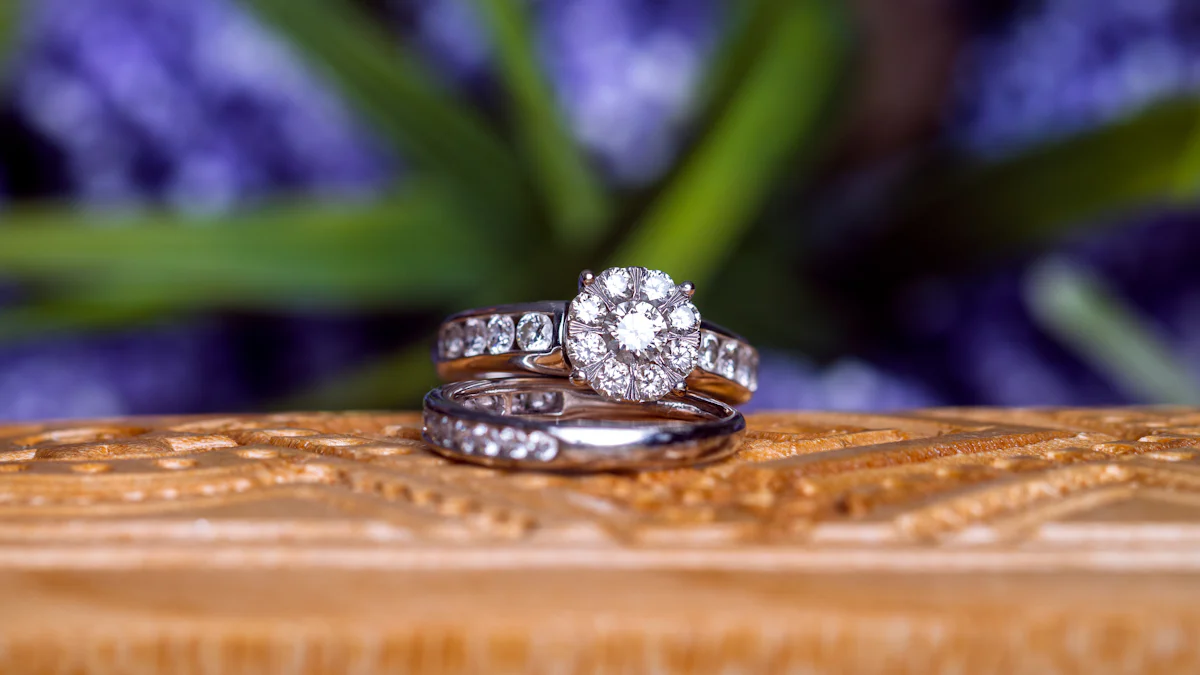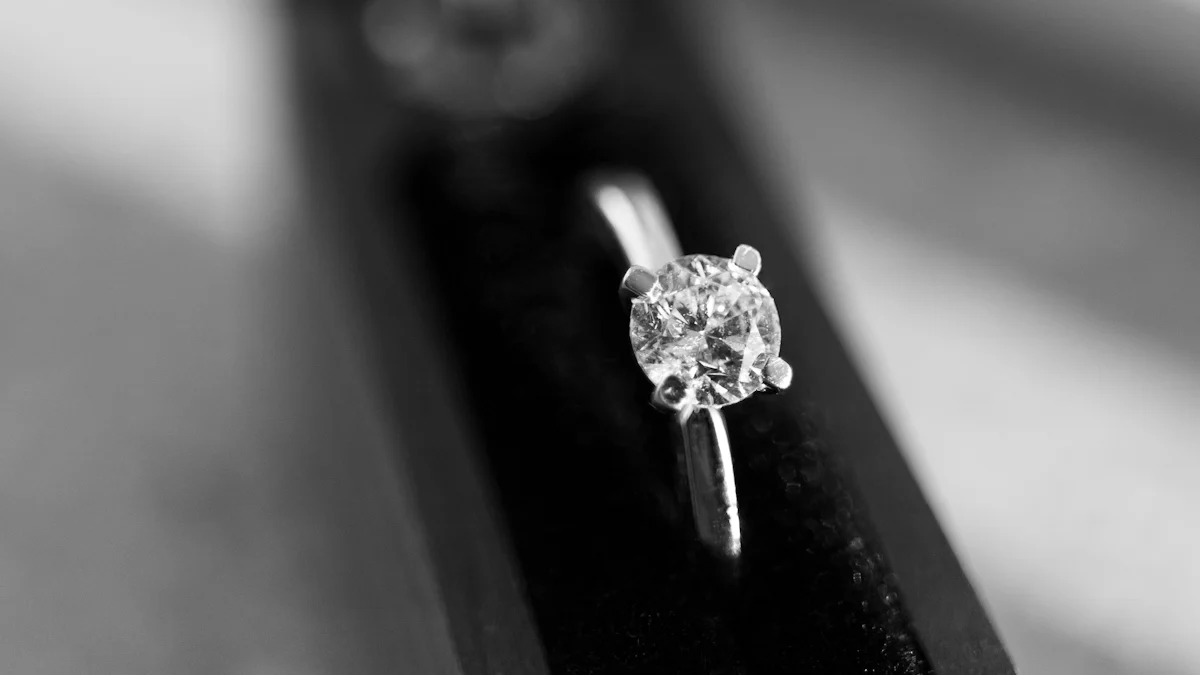Guide to Choosing Diamond Carats for Jewelry

When you think about diamonds, the term "carat" often comes to mind. But what exactly does it mean? A diamond carat measures the weight of a diamond, not its size. This unit of measurement plays a crucial role in determining a diamond's value and appeal. In the U.S., the average engagement ring features a diamond weighing around 1.2 carats. While larger carats often catch the eye, they also come with a heftier price tag. Understanding diamond carats helps you make informed choices, ensuring your jewelry reflects both your style and budget.
Key Takeaways
- Understand that carat measures weight, not size; two diamonds of the same carat can look different based on their cut and shape.
- Larger carat diamonds are rarer and more expensive, but balance carat weight with cut, color, and clarity for the best value.
- Consider your personal style and lifestyle when choosing carat size; a diamond should enhance your look without overwhelming it.
- Set a budget before shopping to help narrow down options and focus on diamonds that meet your quality expectations.
- Consult with a jeweler for personalized guidance and to visualize how different carat sizes will look on you.
- Reflect on the emotional significance of your diamond choice; it should represent personal values or milestones.
- Remember that smaller carat diamonds can offer versatility and practicality, making them ideal for everyday wear.
Understanding Diamond Carats
What is a Carat?
When you hear the term "carat," you might think it refers to the size of a diamond. However, a carat actually measures the weight of the diamond. One carat equals 200 milligrams and can be divided into 100 points for more precise measurements. This unit of measurement is crucial in the diamond industry. It helps jewelers and buyers understand the weight and, indirectly, the size of the diamond.
Many people mistakenly equate carat weight with size. While a larger carat weight often means a bigger diamond, the actual appearance depends on the stone's dimensions and how it holds its weight. For instance, two diamonds with the same carat weight might look different in size due to their cut and shape. So, when you're choosing diamond carats, remember that weight doesn't always equal size.
The Importance of Carat Weight in Jewelry
Carat weight plays a significant role in determining a diamond's value. Generally, larger diamonds are rarer and more desirable, which drives up their price. A one-carat diamond can be significantly more expensive than a half-carat diamond of the same quality. This is because the rarity of larger diamonds makes them more valuable.
However, carat weight is just one part of the bigger picture. The beauty of a diamond also depends on its cut, color, and clarity. These factors work together to create the overall appeal of the diamond. When you're shopping for jewelry, it's essential to balance carat weight with these other characteristics. A well-cut diamond with excellent color and clarity can be more stunning than a larger diamond with poor quality.
Impact of Carat Weight on Appearance and Cost

How Carat Weight Affects Diamond Size
When you look at diamonds, the carat weight often influences how big they appear. A 1-carat diamond might seem modest compared to a 2-carat diamond, which can have a more striking visual impact. The difference in size perception between these two can be quite noticeable. However, remember that carat weight doesn't always tell the whole story. The cut and shape of the diamond also play a significant role in how large it looks. For example, certain shapes like oval or marquise can make a diamond appear larger than its actual carat weight suggests.
You might wonder why two diamonds with the same carat weight can look different. This happens because of how the diamond holds its weight. Some diamonds are cut deeper, while others are cut shallower, affecting their face-up size. So, when choosing diamond carats, consider not just the weight but also the cut and shape to get the appearance you desire.
The Relationship Between Carat Weight and Price
Carat weight significantly impacts the price of a diamond. As the carat weight increases, the price tends to rise, but not always in a linear fashion. For instance, a 2-carat diamond is often much more expensive than a 1-carat diamond, even though it's only twice the weight. This price jump occurs because larger diamonds are rarer and more sought after. The rarity of the rough material needed for larger diamonds drives up their cost.
However, the price isn't solely determined by carat weight. The cut, color, and clarity of the diamond also influence its value. Two diamonds with the same carat weight can have vastly different prices based on these factors. When you're shopping, it's essential to balance these elements to find a diamond that fits your budget and meets your quality expectations. By understanding these nuances, you can make a more informed decision and choose a diamond that truly reflects your style and financial considerations.
Choosing the Right Carat Size

Selecting the perfect carat size for your diamond jewelry involves more than just picking a number. You need to consider several personal factors to ensure the diamond complements your style and lifestyle. Let's explore these considerations to help you make a choice that feels just right.
Personal Style Considerations
Your personal style plays a significant role in choosing the right diamond carat size. Do you prefer subtle elegance or bold statements? If you lean towards minimalism, a smaller diamond might suit you better. On the other hand, if you love making a statement with your jewelry, a larger carat size could be more appealing. Think about your wardrobe and the type of jewelry you usually wear. A diamond should enhance your overall look, not overshadow it.
Consider how the diamond will fit into your existing collection. Will it be a standalone piece or part of a layered look? Your style preferences can guide you in selecting a carat size that aligns with your fashion sense.
Finger Size and Lifestyle Factors
Your finger size and lifestyle are crucial when choosing diamond carats. A diamond that looks perfect on one person might seem too large or small on another. If you have slender fingers, a smaller carat size might appear more proportionate. Conversely, if your fingers are larger, you might prefer a bigger diamond to achieve the desired visual impact.
Lifestyle also influences your choice. If you lead an active lifestyle or work in a profession where you use your hands frequently, a smaller diamond might be more practical. Larger diamonds can be more prone to damage or snagging. Consider how often you'll wear the jewelry and in what settings. A diamond should fit seamlessly into your daily life without causing inconvenience.
Balancing Size, Quality, and Budget
Finding the right balance between size, quality, and budget is key to choosing the perfect diamond. Larger diamonds often come with a higher price tag, but that doesn't mean you have to compromise on quality. It's essential to prioritize what matters most to you. Would you prefer a slightly smaller diamond with exceptional clarity and color, or a larger one with moderate quality?
Set a budget before you start shopping. This will help you narrow down your options and focus on diamonds that meet your criteria. Remember, a well-cut diamond with excellent quality can be more stunning than a larger one with lower attributes. By balancing these factors, you can find a diamond that reflects your style and fits within your financial plan.
Pros and Cons of Different Carat Sizes
Advantages of Larger Carats
When you think about larger carat diamonds, the first thing that might come to mind is their stunning visual appeal. Bigger diamonds often catch the eye with their impressive sparkle and brilliance. They offer a range of aesthetic advantages that can make any piece of jewelry stand out. If you love making a bold statement, a larger carat diamond might be just what you're looking for.
-
Visual Appeal: Larger diamonds naturally draw attention. Their size enhances the overall look of the jewelry, making it a centerpiece in your collection.
-
Sparkle and Brilliance: With more surface area, larger diamonds can reflect more light, resulting in greater sparkle and fire. This can add a touch of glamour to any outfit.
-
Psychological Impact: Owning a larger diamond can also have a psychological effect. It might reflect personal values or self-image, giving you a sense of pride and satisfaction.
However, it's important to remember that larger carats come with a heftier price tag. The rarity of bigger diamonds makes them more expensive. So, if you're considering a larger carat, ensure it aligns with your budget and personal preferences.
Benefits of Smaller Carats
Smaller carat diamonds offer their own set of advantages, especially if you're looking for versatility and practicality. They can fit seamlessly into various styles and settings, making them a popular choice for many.
-
Affordability: Smaller carat weights often allow you more options within your price range. You can focus on other aspects like clarity and color without breaking the bank.
-
Versatility: Smaller diamonds work well with most styles. Whether you prefer a minimalist look or enjoy layering your jewelry, a smaller diamond can complement your wardrobe without overwhelming it.
-
Practicality: If you lead an active lifestyle, a smaller diamond might be more practical. It's less prone to damage or snagging, making it ideal for everyday wear.
-
Proportional Balance: A smaller diamond can achieve a balanced look, especially if you have slender fingers. It ensures the diamond doesn't appear too large or out of place.
Ultimately, choosing the right carat size comes down to personal preference. Consider what looks best to your eye and what fits your lifestyle. Whether you opt for a larger or smaller carat, the key is to find a diamond that reflects your style and meets your needs.
Expert Tips for Making an Informed Decision
Choosing the right diamond carat size can feel overwhelming, but you don't have to do it alone. Here are some expert tips to help you make a decision that you'll cherish forever.
Consulting with a Jeweler
When it comes to diamonds, jewelers are your best friends. They have the knowledge and experience to guide you through the process. Experts from diamondrensu.com emphasize the importance of seeking professional advice. They say:
"Our expert advice will help you navigate this important decision effortlessly."
Here's how a jeweler can assist you:
- Personalized Guidance: Jewelers can offer insights based on your preferences and budget. They can show you a range of options and explain the differences in quality and price.
- Hands-On Experience: Seeing and trying on different diamonds can give you a better sense of what you like. A jeweler can help you visualize how different carat sizes will look on you.
- Trustworthy Advice: Reputable jewelers prioritize your satisfaction. They aim to educate you about your purchase, ensuring you feel confident in your choice.
Don't hesitate to ask questions. A good jeweler will be happy to share their expertise and help you find the perfect diamond.
Considering the Personal Significance of the Choice
Your diamond choice should reflect more than just aesthetics. It should hold personal significance. Think about what the diamond represents to you. Is it a symbol of love, a milestone, or a personal achievement? Understanding its meaning can guide your decision.
- Emotional Value: Consider the emotional connection you have with the diamond. A smaller diamond with sentimental value might mean more to you than a larger one without personal significance.
- Future Considerations: Think about how the diamond will fit into your life in the future. Will it be a family heirloom? Will it mark a special occasion? These considerations can influence your choice.
- Personal Reflection: Your diamond should reflect who you are. Whether it's a bold statement or a subtle elegance, choose a carat size that aligns with your personality and values.
By consulting with a jeweler and considering the personal significance of your choice, you can make an informed decision that you'll treasure for years to come.
Understanding carat weight is crucial when choosing diamond jewelry. It helps you make informed decisions, ensuring your selection aligns with your style and budget. Remember, carat weight significantly impacts a diamond's price and appearance. Larger diamonds are rarer and often more expensive. However, it's essential to balance carat weight with other factors like cut, color, and clarity.
Consider your personal preferences and lifestyle. Think about what matters most to you—whether it's size, quality, or overall design. Choose a carat weight that fits your budget while still giving you a beautiful piece of jewelry.
FAQ
Why does diamond carat weight matter?
Understanding carat weight is crucial when selecting a diamond. A diamond size chart can guide you in determining the right carat weight by providing a millimeter-to-carat comparison. This chart serves as a reference point, as the diameters of diamonds vary based on cut quality. Knowing this helps you make informed decisions about the size and appearance of your diamond.
How important should carat be when buying a diamond?
Carat weight plays a significant role in a diamond's value and size. It's essential for any buyer to grasp this concept. Carat weight affects the price and visual impact of the diamond. By understanding how to assess and choose diamonds based on their carat weight, you can avoid overspending while still finding a beautiful stone.
What is the significance of carat weight in diamonds?
Carat weight is a critical factor in determining a diamond's value. It refers to the weight of the diamond, not its size. Among the 4Cs (Carat, Cut, Color, Clarity), carat weight is one of the most significant aspects. Larger diamonds are rarer and more expensive per carat than smaller ones, making carat weight a key consideration in diamond engagement rings.
What does carat weight mean when buying a diamond?
Carat weight measures the raw physical mass of gems and diamonds. It's a unique unit applicable only to precious stones. Often mistaken for visual size, carat weight is a scale of measurement that helps you understand the actual mass of the diamond you're purchasing.
How does carat weight impact the price of a diamond?
Carat weight significantly influences the price of a diamond. While it's mostly subjective, carat weight often becomes the most important aspect of the 4Cs in determining a diamond's price. Larger carat weights typically lead to higher prices due to the rarity and desirability of bigger diamonds.
What is the role of carat weight in determining a diamond's value?
Carat weight is a well-known way to measure a diamond's size. Each carat equals 200 milligrams. While a higher carat weight often suggests higher value, other factors like cut, clarity, and color also determine a diamond's worth. A well-balanced diamond with a harmonious combination of carat weight and quality can radiate elegance and brilliance.
How to interpret a diamond carat/size chart?
A diamond carat/size chart provides a visual guide to understanding the relationship between carat weight and visible size. This chart helps you see how different carat weights translate into actual dimensions, aiding in your decision-making process.
What factors should be considered when buying a diamond based on carat weight?
When buying a diamond, balance the size of the stone (carat weight) with its quality. Carat weight often gets the most attention, but it's crucial to consider other elements like cut, clarity, and color. A diamond's total value comes from a mix of attributes, not just carat weight alone.
How to choose the right carat size for a diamond ring?
Choosing the right carat size involves considering how different shapes appear on your hand. For example, a round shape offers a classic appeal, while an oval shape creates an elongated appearance. Consider your personal style and how the diamond will complement your hand and overall look.
What are the dimensions of diamonds based on carat weight?
Understanding the correlation between carat weight and visible size is essential. Diamond dimensions vary depending on the type of cut and the corresponding crown area size. Knowing these dimensions helps you visualize how different carat weights will look in real life.
See Also
Your Ultimate Resource for Choosing a Diamond Ruby Ring
A Comprehensive Approach to Picking a White Diamond Ring
A Deep Dive into Diamond Cuts for Engagement Rings
Essential Tips for Choosing the Right Artificial Diamond Bracelet

